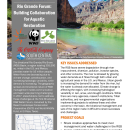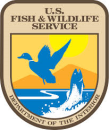Location
States
TexasEcosystem
River/streamIntroduction
The binational Rio Grande/Río Bravo (RGB) Basin, totaling 355,500 sq. miles (920,740 km) in the southwestern U.S. and northern Mexico, is a critical watershed in an arid region. The RGB river forms 1,250 miles (2,011 km) of the border between the U.S. and Mexico, and it provides drinking water and irrigation for 16 million people living in the basin. The Bureau of Reclamation’s climate change climate change
Climate change includes both global warming driven by human-induced emissions of greenhouse gases and the resulting large-scale shifts in weather patterns. Though there have been previous periods of climatic change, since the mid-20th century humans have had an unprecedented impact on Earth's climate system and caused change on a global scale.
Learn more about climate change projections indicate water supply in the basin is decreasing, while demand for that water, even without further development, is increasing as a result of increasing temperatures and evaporation (Rio Grande Basin SECURE Water Report, 2021). Water management decisions in one area affect water quality and quantity, as well as ecosystems, wildlife, and people, throughout the basin. Therefore, there is a need for a shared conservation vision and basin-wide planning to secure the RGB’s future.
The RGB is not currently managed as a singular watershed. The U.S. and Mexico share governance of the border stretch of the river through international water rights treaties. Water that runs through U.S. territory is managed by U.S. state and federal authorities; the Río Bravo del Norte - as the Rio Grande is known in Mexico - is also managed by Mexican authorities; and the U.S. and Mexican sections of the International Boundary and Water Commission help regulate the Treaty of 1944 between the two countries. Individual stretches and watersheds are managed by separate authorities, including First Nations, municipalities, and water conservation districts. The geographic spread and binational nature of RGB management makes communication and basin-wide planning challenging.
In order to improve coordination throughout the entire basin, staff from the Desert Landscape Conservation Cooperative (DLCC), a regional partnership in the southwestern U.S. directed by the U.S. Department of the Interior, and World Wildlife Fund (WWF), worked with government and nonprofit partners to convene a whole basin conference in 2017. A list of the members of the organizing committee can be found here. The Binational RGB Water Forum, held in El Paso Texas, successfully brought together stakeholders from throughout the basin to share projects, highlight successes, identify common concerns, and brainstorm solutions for the long-term health of the river. Over 180 experts representing all segments of the RGB; including farmers, ranchers, city officials, Tribal leaders, policymakers, business leaders, conservationists, and scientists from the U.S. and Mexico; attended the event. They discussed topics such as growing water demands, invasive species invasive species
An invasive species is any plant or animal that has spread or been introduced into a new area where they are, or could, cause harm to the environment, economy, or human, animal, or plant health. Their unwelcome presence can destroy ecosystems and cost millions of dollars.
Learn more about invasive species , climate change impacts, ecosystem functions, and alterations that affect the RGB’s flow and water quality.
Key Issues Addressed
The RGB water governance system is complex, with multiple river impoundments, diversions, and management objectives and policies. The river is stressed by growing water demands as it flows through both urban and agricultural areas in the U.S. and Mexico. Urban growth is increasing the demand for water from the river, but most water is already allocated, with up to 83% of withdrawals for agricultural uses (International Boundary and Water Commission). Water quality is impaired by increased salinity and nutrient loading from municipalities and ranching. Invasive species choke some areas of the channel and affect forested uplands in other parts of the basin.
These issues are magnified by climate change. Temperatures throughout the region are projected to increase by 4-8 °F during the 21st century (Reclamation, SECURE Water Act Report 03/2021). Higher temperatures will increase evaporation and decrease groundwater recharge, which is a significant source of flow in the RGB Basin. Snowfall will transition to rainfall, with decreased spring run-off from snow melt. Hydrologic variability is increasing overall throughout the basin, including longer and more intense droughts interspersed with floods.
There are many individual projects being implemented by agencies, Tribal authorities, non-governmental organizations, and research institutions to address water issues for human and natural communities throughout the watershed. However, because the RGB is large and management is interstate and binational, the projects being implemented to address challenges in one part of the watershed are not always widely known or shared throughout the basin.
Project Goals
- Share creative approaches to meet river management and water challenges in the RGB
- Inspire collaboration by highlighting successful conservation projects throughout the basin
- Build relationships and partnerships that will lead to long-term solutions
Project Highlights
(Not) Lost in Translation: With equal representation from Mexico and U.S. stakeholders, the Forum provided Spanish and English language translation for all presenters and printed materials throughout the conference.
- Planning and Partners: The planning committee for the Binational RGB Forum included representatives from the DLCC, the World Wildlife Fund, The Coca-Cola Company, the Tecnológico de Monterrey, the USGS South Central Climate Science Center, the Rio Grande Joint Venture, and the Instituto Mexicano de Tecnología del Agua. The committee started meeting in 2015. The DLCC was already in partnership with individuals and organizations in both countries. The WWF brought expertise from Mexico and leveraged funding through their partnership with Coca-Cola. DJ Case and Associates facilitated the meetings and output of the committee. Members of the original committee continue to meet regularly to plan the next Forum, and this informal group serves as a hub for connecting programming throughout the basin.
- Brainstorming Solutions: Forum participants proposed a number of solutions to address the landscape-wide challenges faced by the people and lands of the RGB Basin. These included management of invasive species, speaking of the river as a whole, purchasing/transferring/leasing irrigation rights, focusing on groundwater supply, addressing municipal water conservation, desalinating water, and modeling water supply and consumption. To implement any of these solutions, participants emphasized that it was essential to improve basin-wide communication and collaboration on water issues. Forum attendees agreed that the basin’s water management challenges need to be addressed by a diverse coalition, representing urban and rural, social and scientific, and industry and agricultural interests.
- Forum Satisfaction: The Binational RGB Water Forum was a well-received event and succeeded in presenting the RGB Basin as one river. Sixty-eight percent of attendees said they heard about solutions and innovations relevant to their work within the basin. Seventy-five percent said they formed new relationships among colleagues. Ninety-seven percent said they wanted to see another Forum convened. Many participants expressed a desire to continue the conversations throughout the basin.
- Technical Report: The World Wildlife Fundcompleted the English and Spanish versions of the technical report summarizing Forum results in mid-September 2018. The report was distributed electronically to all Binational RGB Forum participants and is available to all interested parties via WWF’s website and websites of partnering organizations.
Lessons Learned
Forum attendees proposed many creative solutions to basin-wide management issues, many drawing upon models already found in the RGB watershed. For example, more municipalities could adopt water policies that allow saved water to be legally stored, credited, and protected from depletion upstream or downstream. Forum participants also recommended learning from irrigation districts across the Southwest that have implemented water conservation programs through improved water conveyance and diversion mechanisms. Forum attendees also discussed water markets as a way to transfer more water flow equitably to cities while providing revenue for farmers. However, these solutions need to be further researched for replicability and expansion throughout the region.
Binational RGB Water Forum participants noted the benefits of testing projects on a small scale. It is unrealistic and even counterproductive to tackle big issues all at once. In addition, several Forum participants noted that some solutions may be appropriate to specific geographies or parts of the basin, but not in others.
The Binational RGB Water Forum was planned by staff from the partner organizations in addition to their regular responsibilities. In the future, the committee recommends hiring a coordinator specifically for future Forum planning and implementation. The committee did hire professional facilitation for the planning committee. Working with DJ Case and Associates helped the organizing committee stay organized, move forward, and resolve conflicts. For example, organizing committee members had many different perspectives on what topics to include in the Forum that would be of most interest to participants. DJ Case’s facilitation helped the committee work through a decision process that met everyone’s goals in the limited time they had to plan the Forum.
After the event, there was a lot of interest in next steps. One organizer noted that having a plan prior for who would conduct the follow up and how it would happen would have been a good way to capture more of the enthusiasm and momentum generated by the Forum.
The DLCC ceased to operate shortly after the Forum was held, and there was a lack of capacity to continue funding and provide support for additional binational, basin-wide meetings. However, various stakeholders are now working on creating new opportunities to bring people together throughout the basin.
Next Steps
- Create more partnerships and build relationships across sectors, making sure to involve decision makers and major users of water, as well as broader representation from Tribal authorities and the private sector
- Fund and conduct more research to examine groundwater and water quality further
- Promote interdisciplinary collaboration and increase communications by putting research and projects together in one place
- Schedule regular video conferences and use social media and videos to educate a wider range of audiences
- Identify other stakeholders: for example, lawmakers at the municipal, state, and federal levels, via presenting concrete proposals for solutions
- Plan future gatherings: Participants were enthusiastic about holding a future forum to cement partnerships and collaborate on solutions across the basin. Organizers are exploring when and where a future forum might be held
Funding Partners
- Coca-Cola Foundation
- World Wildlife Fund
- Desert Landscape Conservation Cooperative
- South Central Climate Adaptation Science Center
Resources
- Binational Population Data in Sister Cities along the Rio Grande - Texas Commission on Environmental Quality
- Bureau of Reclamation. (2021). Rio Grande Basin SECURE Water Act Section 9503(c) Report to Congress. U.S. Department of the Interior.
- International Boundary and Water Commission (IBWC) Treaties Between the U.S. and Mexico
- World Wildlife Fund (2018). Water scarcity in the Rio Grande/Bravo Watershed: Challenges and Solutions. Results of Binational Rio Grande/Bravo Water Forum (November 7-8, 2017)
- Schmandt, J. (2002). Bi-national water issues in the Rio Grande/Rı́o Bravo basin.Water Policy. 4: 2. 137-155.
- Desert Landscape Conservation Cooperative
Contact
Genevieve Johnson, Bureau of Reclamation: gjohnson@usbr.gov
CART Lead Author
Lindsey Smith, CART Student Author, Miami University
Suggested Citation
Smith, L. (2023). “Rio Grande Forum: Building Collaboration for Aquatic Restoration.” CART. Retrieved from https://www.fws.gov/project/collaboration-aquatic-restoration-rio-grande.







